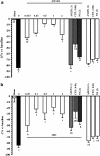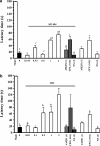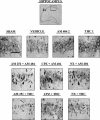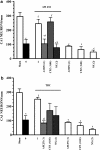Delta9-tetrahydrocannabinol (THC) and AM 404 protect against cerebral ischaemia in gerbils through a mechanism involving cannabinoid and opioid receptors
- PMID: 17965746
- PMCID: PMC2189998
- DOI: 10.1038/sj.bjp.0707514
Delta9-tetrahydrocannabinol (THC) and AM 404 protect against cerebral ischaemia in gerbils through a mechanism involving cannabinoid and opioid receptors
Abstract
Background and purpose: It has been suggested that the endocannabinoid system elicits neuroprotection against excitotoxic brain damage. In the present study the therapeutic potential of AM 404 on ischaemia-induced neuronal injury was investigated in vivo and compared with that of the classical cannabinoid receptor type 1 (CB1) agonist, delta 9-tetraydrocannabinol (THC), using a model of transient global cerebral ischaemia in the gerbil.
Experimental approach: The effects of AM 404 (0.015-2 mg kg(-1)) and THC (0.05-2 mg kg(-1)), given 5 min after ischaemia, were measured from 1 h to 7 days in terms of electroencephalographic (EEG) total spectral power, spontaneous motor activity, memory function, rectal temperature and hippocampal CA1 neuronal count.
Key results: Over the dose range tested, AM 404 (2 mg kg(-1)) and THC (1 mg kg(-1)) completely reversed the ischaemia-induced behavioural, EEG and histological damage. Only THC (1 and 2 mg kg(-1)) induced a decrease of body temperature. Pretreatment with the selective CB1 receptor antagonist, AM 251 (1 mg kg(-1)) and the opioid antagonist, naloxone (2 mg kg(-1)) reversed the protective effect induced by both AM 404 and THC while the TRPV1 vanilloid antagonist, capsazepine (0.01 mg kg(-1)), was ineffective.
Conclusions and implications: Our findings demonstrate that AM 404 and THC reduce neuronal damage caused by bilateral carotid occlusion in gerbils and that this protection is mediated through an interaction with CB1 and opioid receptors. Endocannabinoids might form the basis for the development of new neuroprotective drugs useful for the treatment of stroke and other neurodegenerative pathologies.
Figures





Similar articles
-
Non-cannabinoid CB1, non-cannabinoid CB2 antinociceptive effects of several novel compounds in the PPQ stretch test in mice.Eur J Pharmacol. 2006 Sep 28;546(1-3):60-8. doi: 10.1016/j.ejphar.2006.07.024. Epub 2006 Jul 25. Eur J Pharmacol. 2006. PMID: 16919265
-
Discriminative stimulus functions of AM-1346, a CB1R selective anandamide analog in rats trained with Delta9-THC or (R)-methanandamide (AM-356).Psychopharmacology (Berl). 2006 Oct;188(3):315-23. doi: 10.1007/s00213-006-0517-x. Epub 2006 Sep 5. Psychopharmacology (Berl). 2006. PMID: 16953384
-
Polydeoxyribonucleotide (defibrotide) protects against post-ischemic behavioral, electroencephalographic and neuronal damage in the gerbil.Eur J Pharmacol. 1997 Jun 11;328(2-3):143-52. doi: 10.1016/s0014-2999(97)83040-3. Eur J Pharmacol. 1997. PMID: 9218696
-
New perspectives in the studies on endocannabinoid and cannabis: abnormal behaviors associate with CB1 cannabinoid receptor and development of therapeutic application.J Pharmacol Sci. 2004 Dec;96(4):362-6. doi: 10.1254/jphs.fmj04003x2. Epub 2004 Dec 10. J Pharmacol Sci. 2004. PMID: 15599103 Review.
-
Roles of transient receptor potential vanilloid subtype 1 and cannabinoid type 1 receptors in the brain: neuroprotection versus neurotoxicity.Mol Neurobiol. 2007 Jun;35(3):245-54. doi: 10.1007/s12035-007-0030-1. Mol Neurobiol. 2007. PMID: 17917113 Review.
Cited by
-
Aquaporin 4 and the endocannabinoid system: a potential therapeutic target in brain injury.Exp Brain Res. 2024 Sep;242(9):2041-2058. doi: 10.1007/s00221-024-06896-7. Epub 2024 Jul 23. Exp Brain Res. 2024. PMID: 39043897 Free PMC article. Review.
-
Neuroprotective Effect of AM404 Against NMDA-Induced Hippocampal Excitotoxicity.Front Cell Neurosci. 2019 Dec 20;13:566. doi: 10.3389/fncel.2019.00566. eCollection 2019. Front Cell Neurosci. 2019. PMID: 31920563 Free PMC article.
-
Cannabinoids and Epilepsy.Neurotherapeutics. 2015 Oct;12(4):747-68. doi: 10.1007/s13311-015-0375-5. Neurotherapeutics. 2015. PMID: 26282273 Free PMC article. Review.
-
Cannabinoids and Dementia: A Review of Clinical and Preclinical Data.Pharmaceuticals (Basel). 2010 Aug 17;3(8):2689-2708. doi: 10.3390/ph3082689. Pharmaceuticals (Basel). 2010. PMID: 27713372 Free PMC article. Review.
-
Cannabinoid as a neuroprotective strategy in perinatal hypoxic-ischemic injury.Neurosci Bull. 2011 Aug;27(4):275-85. doi: 10.1007/s12264-011-1008-6. Neurosci Bull. 2011. PMID: 21788999 Free PMC article. Review.
References
-
- Araki H, Nojiri M, Kawashima K, Kimura M, Aihara H. Behavioral, electroencephalographic and histopathological studies on mongolian gerbils with occluded common carotid arteries. Physiol Behav. 1986;38:89–94. - PubMed
-
- Bahr BA, Karanian DA, Makanji SS, Makriyannis A. Targeting the endocannabinoid system in treating brain disorders. Expert Opin Investig Drugs. 2006;15:351–365. - PubMed
-
- Battista N, Fezza F, Finazzi-Agro A, Maccarrone M. The endocannabinoid system in neurodegeneration. Ital J Biochem. 2006;55:283–289. - PubMed
MeSH terms
Substances
LinkOut - more resources
Full Text Sources
Miscellaneous

